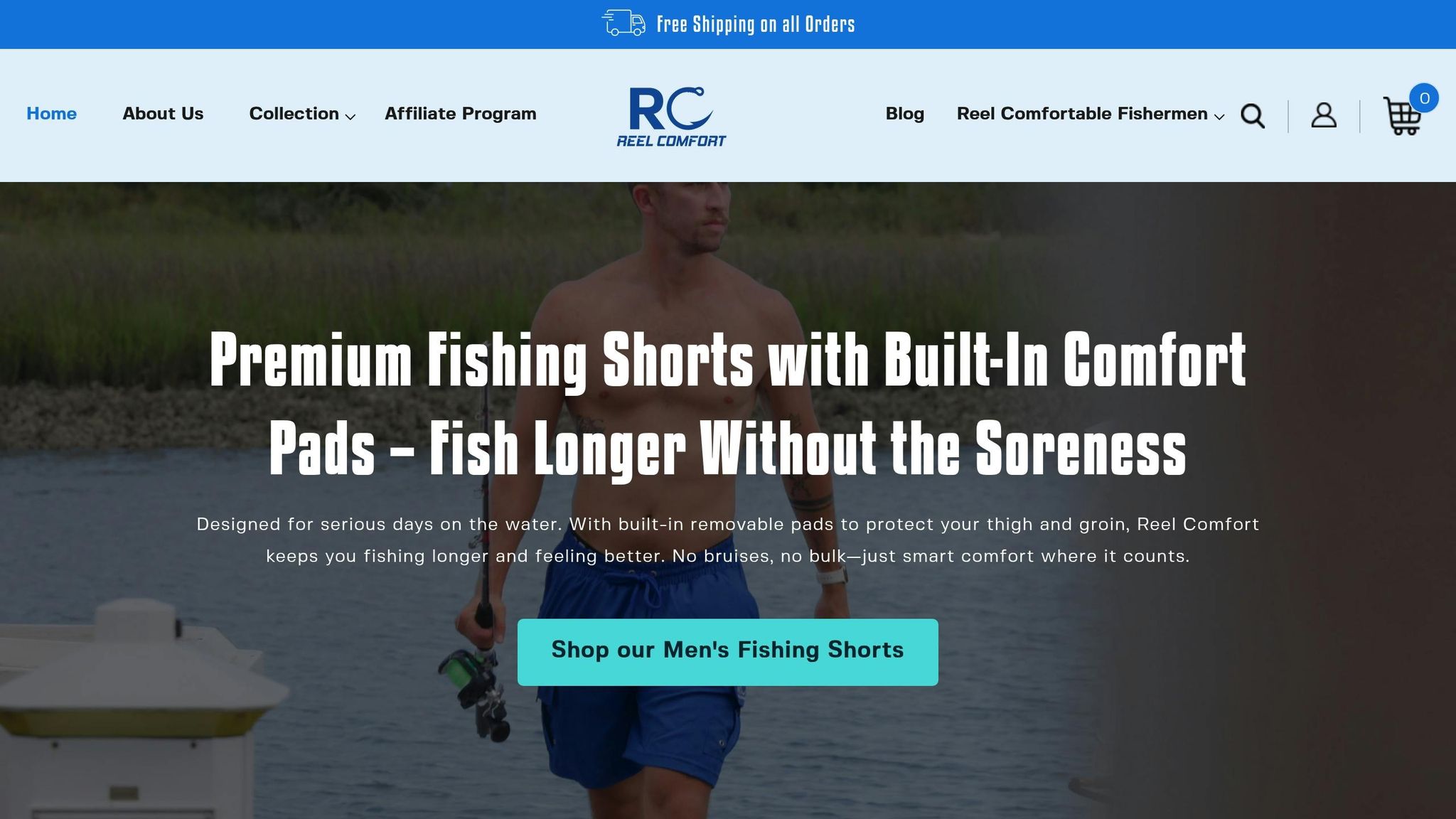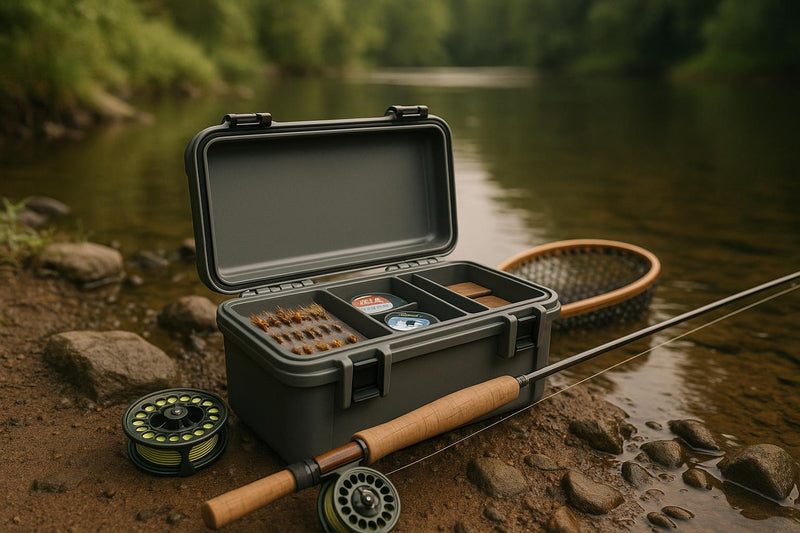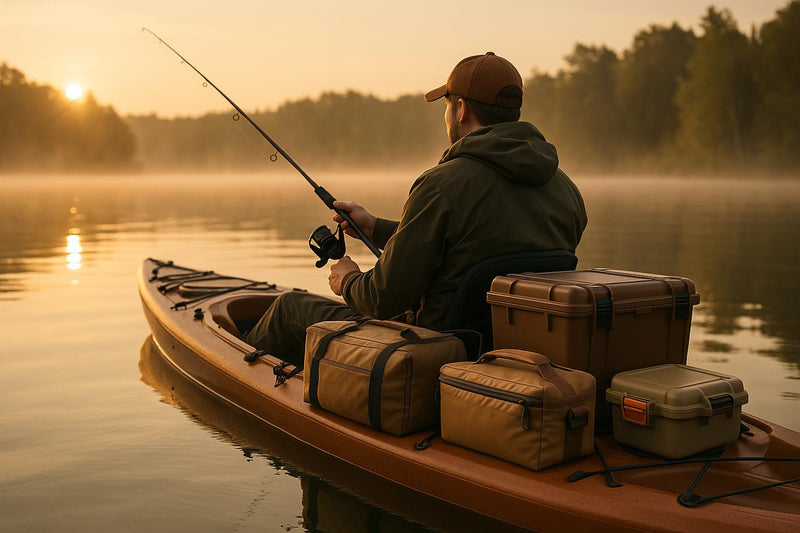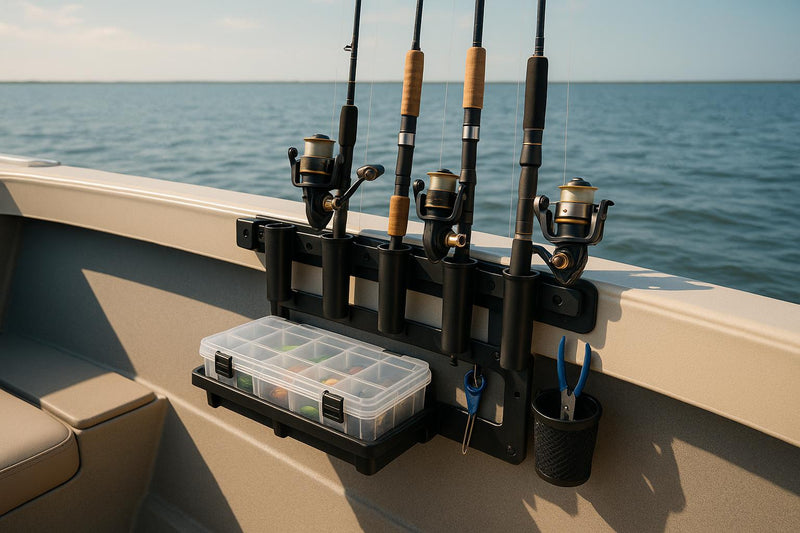When it comes to staying dry during fishing trips, you have two main options: waterproofing sprays for existing gear or water-resistant fabrics built into apparel. Here’s the difference:
- Waterproofing Sprays: These sprays coat your gear with a water-repellent layer. They’re affordable, easy to apply, and great for refreshing older clothing. However, they require frequent reapplication and can wear off over time. Best for occasional anglers or light rain protection.
- Water-Resistant Fabrics: These materials are manufactured to repel water, offering consistent, long-lasting protection. They’re durable, breathable, and require minimal upkeep. Ideal for frequent anglers or those facing harsher conditions.
Quick Comparison
| Feature | Waterproofing Spray | Water-Resistant Fabric |
|---|---|---|
| Water Protection | Temporary, depends on application | Built-in, consistent |
| Durability | Fades with use and washing | Long-lasting |
| Cost | Lower upfront cost | Higher initial investment |
| Maintenance | Needs reapplication | Minimal upkeep |
| Breathability | May reduce airflow | Designed for comfort |
For occasional use, sprays are a budget-friendly fix. For long-term performance, invest in water-resistant fabrics like Reel Comfort fishing shorts with built-in protection. Choose based on your fishing habits and weather conditions.
Understanding Waterproofing Spray Treatments
Waterproofing sprays provide a layer of water resistance to your gear without changing its appearance or texture. By creating an invisible barrier on fabric surfaces, these sprays can turn everyday clothing into water-resistant apparel.
How Waterproofing Sprays Work
These sprays rely on water-repellent polymers that bond with fabric fibers, forming a breathable shield. This barrier causes water to bead and roll off the surface while still allowing air and moisture, like sweat, to pass through. Essentially, the fabric's surface is altered at a molecular level to maintain both durability and breathability.
"Nikwax treatments coat fabric and leather fibers with a network of elastic TX.10i water-repellent molecules. They bond to anything that is not water-repellent, but leave the spaces between fibers open and breathable." - Nikwax NA
When treated fabric comes into contact with water, the liquid forms droplets and slides off instead of soaking in. This is thanks to polymers like TX.10i, which create a semi-porous shield. This design ensures that external moisture is repelled while internal moisture escapes, keeping the material comfortable.
"The best waterproofing sprays for garments don't create a complete seal, instead, they remain semi-porous which allows the material to be breathable so moisture doesn't become trapped inside." - Greenbelly Meals
Applying waterproofing spray is a simple process but requires some care. Begin by thoroughly cleaning the fabric. Hold the spray can about 6–8 inches from the surface and apply an even coat using slow, sweeping motions. For example, Scotchgard Fabric Water Shield suggests applying two light coats rather than one heavy layer for the best results. After application, let the fabric dry overnight at room temperature (around 70°F). Keep in mind that cooler or more humid conditions might extend the drying time.
Next, let’s dive into the benefits and limitations of these treatments.
Pros and Cons of Waterproofing Sprays
Waterproofing sprays are an affordable and versatile solution for treating various fabrics, including cotton, polyester, silk, and wool. They can extend the lifespan of your gear and offer a practical way to refresh older items.
However, they do come with some downsides. Frequent reapplication is necessary - most sprays need to be reapplied after washing or at least once a year to maintain their effectiveness. The durability of the treatment is also limited, as it can wear off over time due to regular use, washing, or UV exposure. Additionally, applying the spray can be time-consuming, especially when dealing with multiple or intricate garments.
Best Use Cases for Waterproofing Sprays
Despite their limitations, waterproofing sprays shine in specific situations. They are particularly useful when flexibility and cost savings are important. For instance, they’re great for refreshing older gear, like a favorite fishing vest or a trusty pair of pants, giving them a new lease on life.
Sprays are ideal for light rain protection. If you’re heading out in a drizzle or dealing with morning dew, these treatments provide enough resistance without the need for heavy-duty gear. They’re also a handy temporary fix when your gear starts losing its original water resistance, offering a stopgap solution until you’re ready to invest in more specialized apparel.
Another smart use of waterproofing sprays is during the trial phase of building your outdoor wardrobe. Before committing to pricier, specialized gear, you can experiment with different levels of protection to find what suits your needs. This way, when you’re ready to upgrade, you’ll have a clearer idea of what features, like quick-dry fabric technology, are worth the investment.
Notably, advancements in spray technology, like Nikwax’s updated formulations from 2004–2005, have made these treatments more durable and efficient. These newer versions deliver more applications per bottle and don’t require heat activation, unlike older fluorocarbon-based products.
Understanding Water-Resistant Fabrics
Water-resistant fabrics are designed to keep moisture at bay by incorporating water-repelling properties right into the material during production. Unlike spray-on treatments that simply coat the surface, these fabrics are built to resist water from the inside out.
How Water-Resistant Fabrics Are Made
These fabrics are often crafted using synthetic fibers like polyester and nylon, which naturally resist water absorption. Manufacturers enhance this resistance by employing tight weave constructions, effectively minimizing gaps between fibers and creating a physical barrier against water droplets. To further boost performance, chemical treatments like Durable Water Repellent (DWR) coatings are applied during production.
For even greater protection, some high-performance fabrics incorporate membrane technology. This involves laminating a thin, microporous layer between the fabric's outer and inner layers. The result? A material that lets moisture vapor (like sweat) escape while blocking liquid water. Another advanced technique involves infusing polymer treatments directly into the fiber solution before weaving, ensuring water resistance is embedded throughout the material rather than just on the surface.
Together, these techniques - tight weaves, DWR coatings, and membrane layers - create fabrics that deliver long-lasting and dependable water protection.
Key Benefits of Water-Resistant Fabrics
One standout feature of water-resistant fabrics is their durability. Since the water-repelling properties are built into the material, they remain effective even after multiple washes. This ensures consistent protection across the entire garment.
Another advantage is breathability. These fabrics are designed to let moisture vapor escape while keeping liquid water out, making them perfect for staying comfortable during long, active days. Plus, their low-maintenance nature - requiring only a simple wash with mild detergent - makes them a practical choice for outdoor enthusiasts.
Common Applications in Fishing Apparel
Thanks to their durability and ease of care, water-resistant fabrics are a top choice for fishing gear. They’re specially designed to handle splashes, spray, and high humidity, making them ideal for anglers. For instance, Fishing shorts offer built-in moisture protection to keep you comfortable during long hours on the water. For men seeking a tailored option, our Mens Fishing Shorts combine comfort with reliable water resistance.
In short, water-resistant fabrics are a smart pick for fishing apparel. They provide lasting protection and enhanced comfort, ensuring you stay dry and at ease, no matter the conditions.
Waterproofing Spray vs. Water-Resistant Fabric Comparison
Let’s break down the differences between waterproofing sprays and water-resistant fabrics so you can decide which option fits your fishing needs.
Features and Performance Comparison Table
| Feature | Waterproofing Spray | Water-Resistant Fabric |
|---|---|---|
| Water Protection | Offers varying levels of protection depending on the product and how it’s applied | Provides consistent, built-in water resistance across the entire garment |
| Breathability | Can reduce breathability due to the coating | Designed to maintain good airflow and comfort |
| Upfront Cost | Typically less expensive per application | Higher initial cost as part of the garment's construction |
| Long-term Value | Requires repeated applications as protection fades | Delivers lasting protection without ongoing treatments |
| Maintenance | Needs periodic reapplication | Minimal effort - standard washing usually suffices |
| Application Time | Requires time and care to apply properly | Ready to use without extra steps |
| Durability | Wears off with use and washing | Built-in resistance ensures long-lasting performance |
| Coverage Consistency | Can be uneven if not applied carefully | Guarantees uniform water resistance throughout the material |
This table highlights how each option performs, helping you match your fishing gear with the right type of protection.
Choosing the Right Option for Your Fishing Gear
Your choice between waterproofing sprays and water-resistant fabrics depends on your fishing habits, budget, and gear type.
Go for waterproofing sprays if you’re looking to add temporary protection to existing gear. They work well on items like cotton or canvas fishing shorts, vintage clothing, or budget-friendly gear that lacks built-in resistance. This option is ideal for occasional anglers who fish a few times a season and don’t mind the extra upkeep.
Invest in water-resistant fabrics if you’re buying new fishing apparel or upgrading your gear. For avid anglers who spend long hours on the water, garments with built-in water resistance - like quality fishing shorts - offer consistent performance without the hassle of reapplying treatments.
Your environment also plays a role. If you often face heavy spray, rain, or saltwater, water-resistant fabrics provide reliable, all-day protection without worrying about missed spots or uneven coverage.
In the long run, water-resistant fabrics offer better durability and save time compared to the recurring costs and maintenance of sprays. A solid pair of men’s fishing shorts with built-in water resistance ensures comfort and protection season after season.
For more details on modern fabric technologies, check out this guide on quick-dry fabric technology.
sbb-itb-cb0a783
Premium Fishing Shorts for Water Protection
When it comes to staying dry and comfortable on the water, premium fishing gear has stepped up with all-in-one solutions. For anglers looking for lasting water protection, built-in water resistance is a game-changer. Enter Reel Comfort's fishing shorts, designed specifically for serious fishing enthusiasts.
Key Features of Reel Comfort Fishing Shorts

Reel Comfort’s Men’s Fishing Shorts showcase the benefits of built-in water resistance. Made with quick-dry, water-resistant fabric, these shorts are ready to perform right out of the box - no extra treatments required.
One standout feature is the removable thigh pads, which provide essential support when bracing a rod during those long battles with fish. Don’t need them? Simply take them out for more flexibility based on your fishing style. The shorts also include four-way stretch panels with reinforced stitching, ensuring comfort and durability for long hours on the water. Whether you’re casting, reeling, or maneuvering around the boat, the fabric moves with you.
Storage is another area where these shorts shine. They’re equipped with deep hand pockets, a secure zippered back pocket, and slim thigh-pad pockets, keeping all your essentials within easy reach. Plus, the durable rip-stop fabric resists tears from hooks, tackle, and rugged boat surfaces, making these shorts a reliable choice for any fishing adventure.
Why Anglers Choose Reel Comfort
Reel Comfort fishing shorts strike the perfect balance of design, durability, and mobility, making them a top pick for anglers who spend long days on the water. Unlike shorts that rely on waterproof sprays, these come with built-in, consistent protection across the entire garment.
Anglers also rave about the lightweight, breathable fabric that keeps you comfortable throughout the day. With a 5.0 out of 5-star rating on Amazon and a price of $59.99, these shorts deliver professional-grade features without the hassle or extra costs of reapplying waterproof treatments.
For more tips on how water-resistant gear can make a difference, check out this guide on water-resistant gear protection.
Where to Buy Reel Comfort Fishing Shorts
Reel Comfort fishing shorts can be purchased directly from the official website or on Amazon.com. The official site offers the full selection and direct customer support, while Amazon provides fast shipping options, especially for Prime members.
Available in Black, Gray, Blue, and Tan, these shorts come in sizes ranging from Small to XX-Large, ensuring a great fit for every angler. Both platforms list the shorts at $59.99.
Ready to upgrade your fishing gear? Explore the full collection and find your ideal pair at the padded fishing shorts collection. For a deeper dive into how these compare to regular shorts, check out this handy guide: Padded Fishing Shorts vs. Regular Shorts.
Maintenance and Care Tips for Anglers
Taking care of your gear is essential to keep it in top shape. Whether your apparel has a spray-on waterproof treatment or is crafted from water-resistant fabrics, following the manufacturer's care instructions can go a long way in extending its usability.
Caring for Spray-Treated Apparel
Keeping spray-treated apparel clean is key to maintaining its DWR (Durable Water Repellent) effectiveness. Dirt and grime can reduce the treatment's ability to repel water, so regular cleaning is a must. Always check and follow the care instructions on the label to avoid damaging the treatment.
Maintaining Water-Resistant Fabrics
For clothing made with built-in water-resistant fabrics, proper care ensures the material retains its protective qualities. For example, items like Reel Comfort's fishing shorts are designed to endure tough conditions, but regular cleaning and inspections help them perform better. Check for signs of wear and address them promptly to keep your gear functional and ready for action.
Conclusion
Waterproofing sprays and water-resistant fabrics each bring their own advantages to the table. Waterproofing sprays are a budget-friendly way to add a layer of protection, though they do require regular reapplication. On the other hand, water-resistant fabrics come with built-in moisture protection, offering long-lasting durability and making them a worthwhile choice for anglers who frequently face tough weather or saltwater conditions.
When choosing your gear, consider your fishing habits and budget. If you’re often battling harsh weather or fishing in saltwater, water-resistant fabrics provide reliable, consistent protection. For occasional anglers or those looking to extend the life of their current gear, waterproofing sprays can be a practical and effective option.
Check out Reel Comfort's men’s fishing shorts and premium fishing shorts for built-in water resistance, quick-dry technology, and all-day comfort. Investing in gear that combines water resistance, durability, and comfort can make a big difference in your time on the water.
Whichever option you go with, maintaining your gear properly will ensure it keeps performing season after season. The key is to match the technology of your gear to your fishing conditions, so you can stay dry, comfortable, and focused on reeling in your next catch.
FAQs
How often should I use waterproofing spray to keep my fishing gear protected?
To keep your waterproofing spray working at its best, reapply it every 12 to 24 months. If your gear faces heavy use, frequent water exposure, or goes through multiple washes, you might need to reapply it sooner. Watch for signs like fabric starting to soak through - this is a clear indicator that it’s time for a touch-up.
Why choose water-resistant fabrics instead of waterproofing sprays for fishing apparel?
Water-resistant fabrics are crafted to repel water using specialized weaving methods or durable coatings. These fabrics not only keep water out but also remain breathable and comfortable, making them a perfect choice for outdoor activities like fishing. When you're spending hours on the water, having gear that allows for easy movement and comfort is a game-changer.
On the other hand, waterproofing sprays offer a short-term solution. While they can add a layer of water resistance, they need frequent reapplication, which can become inconvenient over time. Choosing high-quality water-resistant fabrics means you get lasting protection and breathability, making your time on the water far more enjoyable.
Does using waterproofing spray impact the comfort and breathability of fishing gear?
Waterproofing sprays play a key role in keeping your fishing gear both dry and breathable. Many of today’s sprays are designed with a semi-porous structure, meaning they allow moisture to escape while still repelling water. This feature helps maintain airflow, ensuring your gear stays comfortable during long fishing trips or periods of physical activity.
That said, using too much spray or opting for lower-quality products can compromise breathability. This might leave your gear feeling less comfortable, particularly in hot or humid weather. For the best results, apply the spray sparingly and always stick to the manufacturer’s guidelines.




